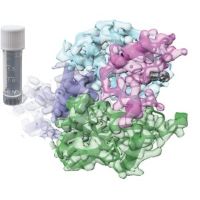Specification
| Organism | Homo sapiens (Human) |
| Expression Host | E.coli |
| Tag Info | Tag-Free |
| Purity | Greater than 95% as determined by SDS-PAGE. |
| Uniprot ID | P23560 |
| Uniprot Entry Name | |
| Gene Names | BDNF |
| Alternative Names | Brain-Derived Neurotrophic Factor; BDNF; Abrineurin |
| Expression Region | Full Length of Mature Protein (129-247aa) |
| Molecular Weight | 13 kDa |
| Endotoxin | Less than 1.0 EU/µg as determined by LAL method. |
| Sequence | HSDPARRGELSVCDSISEWVTAADKKTAVDMSGGTVTVLEKVPVSKGQLKQYFYETKCNPMGYTKEGCRGIDKRHWNSQCRTTQSYVRALTMDSKKRIGWRFIRIDTSCVCTLTIKRGR |
| Product Form | Lyophilized powder (Lyophilized from a 0.2 μm filtered 20 mM PB, 250 mM NaCl, pH 7.2) |
| Reconstitution | Please reconstitute protein in deionized sterile water and we recommend that briefly centrifuge thevial prior to opening the vial .We recommend aliquot for long-term storage at -20℃/-80℃. |
Background
| Relevance | Brain-Derived Neurotrophic Factor (BDNF) is a member of the neurotrophin family. Along with other structurally related neurotrophic factors NGF, NT-3 and NT-4, BDNF binds with high affinity to the TrkB kinase receptor. It also binds with the LNGFR (for low-affinity nerve growth factor receptor, also known as p75). BDNF promotes the survival, growth and differentiation of neurons. It serves as a major regulator of synaptic transmission and plasticity at adult synapses in many regions of the CNS. BDNF expression is altered in neurodegenerative disorders such as Parkinson's and Alzheimer's disease. |
| Function | During development, promotes the survival and differentiation of selected neuronal populations of the peripheral and central nervous systems. Participates in axonal growth, pathfinding and in the modulation of dendritic growth and morphology. Major regulator of synaptic transmission and plasticity at adult synapses in many regions of the CNS. The versatility of BDNF is emphasized by its contribution to a range of adaptive neuronal responses including long-term potentiation (LTP), long-term depression (LTD), certain forms of short-term synaptic plasticity, as well as homeostatic regulation of intrinsic neuronal excitability. |
| Involvement in disease | Bulimia nervosa 2 (BULN2); Congenital central hypoventilation syndrome (CCHS) |
| Subcellular Location | Secreted |
| Protein Families | NGF-beta family |
| Tissue Specificity | Brain. Highly expressed in hippocampus, amygdala, cerebral cortex and cerebellum. Also expressed in heart, lung, skeletal muscle, testis, prostate and placenta. |
| Pathway | cAMPsignalingpathway |
QC Data
| Note | Please contact us for QC Data |
| Product Image (Reference Only) |  |

